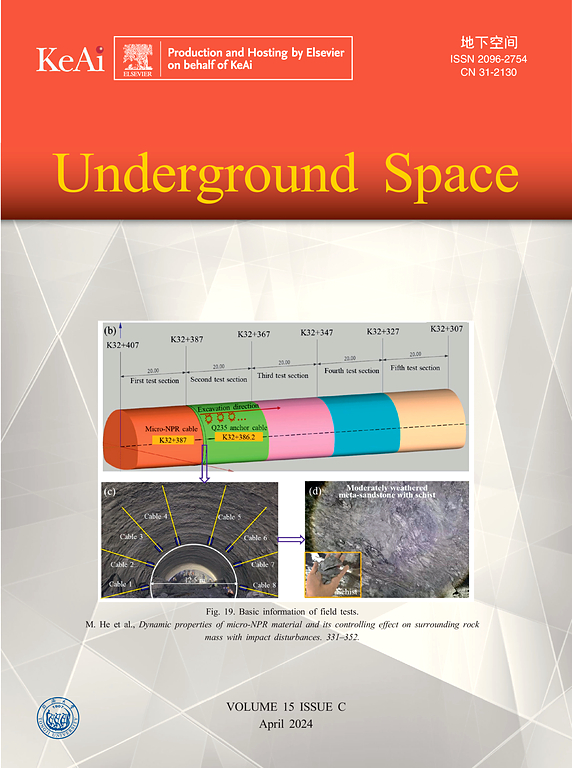能量连续墙的热湿特性及其与邻近地下空间的热湿相互作用
IF 8.3
1区 工程技术
Q1 ENGINEERING, CIVIL
引用次数: 0
摘要
在节能连续墙的设计和应用领域,大量的研究集中在热性能和诱导力学行为上。热湿耦合传递过程及其对邻近地下空间的影响缺乏重视,这是周边高湿环境不可避免的。为此,本文建立了以温度和相对湿度梯度为驱动势的数值模型,研究了电火花放电室内热湿耦合传递的特征。首先,分别研究了夏季和冬季的热湿耦合传递特性,并与纯热模型进行了比较。结果表明,壁面越冷,壁面湿度越大。EDW的运行使热流密度增大。在不考虑水分传递的情况下,抽热季节的热流密度被低估了3.43%以上,注热季节的热流密度被低估了3.90%以上。随后的长期调查表明,潜热通量在过渡季节达到最大值和最小值,其值比感热通量小10倍。夏季感热通量为18.7 W/m2,冬季感热通量为- 27.4 W/m2。由于EDW的运行,地表温度和湿度变化的综合影响使潜热通量峰值降低了14.7%。此外,这些通量的大小受室内条件(室内空气的温度和相对湿度)和EDW的工作温度的影响。因此,进行正交试验以评估由这些参数的变化引起的差异。每个参数的影响在不同的季节(夏季、过渡季节和冬季)有所不同。而室内相对湿度对各季节水汽通量的影响更为显著。本文详细介绍了电炉内的热湿耦合传递过程。此外,还试图提出在地下工程中应用电火花堆焊时,墙体表面的热湿通量对湿热负荷的影响问题。本文章由计算机程序翻译,如有差异,请以英文原文为准。
Hygrothermal behavior of energy diaphragm wall and the induced heat and moisture interaction with adjacent underground space
In the field of design and application of the energy diaphragm wall (EDW), plenty of research was focused on thermal performances and induced mechanical behaviors. The coupled heat and moisture transfer process and the induced impact on the adjacent underground space were lack of attention, which is inevitable due to the high humidity of the surroundings. Therefore, in this paper, a numerical model taking the gradient of the temperature and relative humidity as the driving potential was established to investigate the characteristics of the coupled heat and moisture transfer in the EDW. Firstly, the behavior of the coupled heat and moisture transfer in the summer and winter was investigated separately, and it was compared with the pure thermal model. Results show that the colder the wall surface, the more humid it is. The heat flux is enlarged by the operation of the EDW. Moreover, the heat flux will be underestimated by more than 3.43% in the heat extraction season and by more than 3.90% in the heat injection case if the moisture transfer is not considered. The following long-running investigations have revealed that the latent flux reaches its maximum and minimum value in transition seasons, with a value that is ten times smaller than that of the sensible heat flux. The sensible heat flux reaches 18.7 W/m2 in summer, while in winter it is −27.4 W/m2. The peak latent heat flux is reduced by 14.7% as a result of the combined effect of changes in surface temperature and humidity, due to the operation of the EDW. Additionally, the magnitude of these fluxes is affected by the indoor conditions (temperature and relative humidity of the indoor air) and the operating temperature of EDW. Therefore, an orthogonal test is performed to evaluate how much the discrepancies are induced by variations in those parameters. The impact of each parameter varies across the seasons (summer, transition season, and winter). However, the indoor relative humidity has a more significant influence on the water vapor flux in all the seasons. This paper provided details about the coupled heat and moisture transfer process in the EDW. Moreover, it attempts to raise an issue about the impact on the hygrothermal load induced by the heat and moisture flux through the wall surface when applying EDW in underground engineering.
求助全文
通过发布文献求助,成功后即可免费获取论文全文。
去求助
来源期刊

Underground Space
ENGINEERING, CIVIL-
CiteScore
10.20
自引率
14.10%
发文量
71
审稿时长
63 days
期刊介绍:
Underground Space is an open access international journal without article processing charges (APC) committed to serving as a scientific forum for researchers and practitioners in the field of underground engineering. The journal welcomes manuscripts that deal with original theories, methods, technologies, and important applications throughout the life-cycle of underground projects, including planning, design, operation and maintenance, disaster prevention, and demolition. The journal is particularly interested in manuscripts related to the latest development of smart underground engineering from the perspectives of resilience, resources saving, environmental friendliness, humanity, and artificial intelligence. The manuscripts are expected to have significant innovation and potential impact in the field of underground engineering, and should have clear association with or application in underground projects.
 求助内容:
求助内容: 应助结果提醒方式:
应助结果提醒方式:


